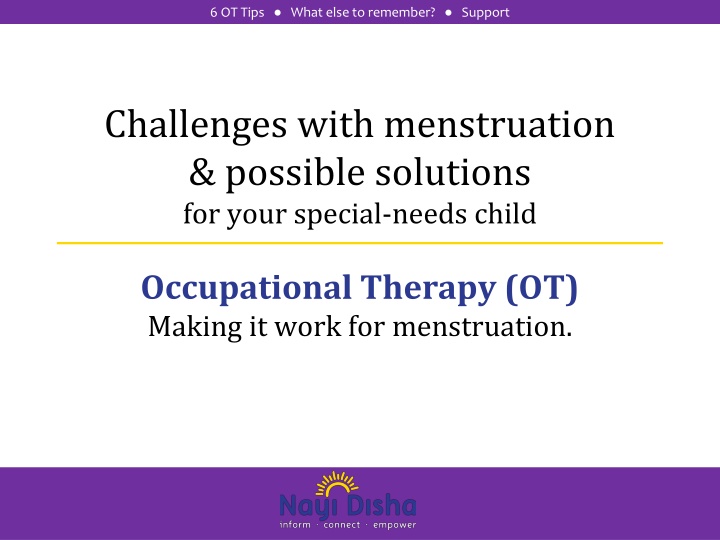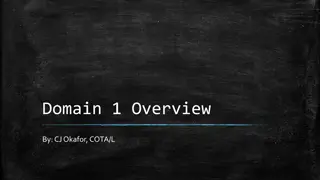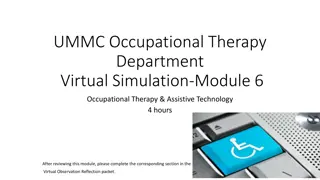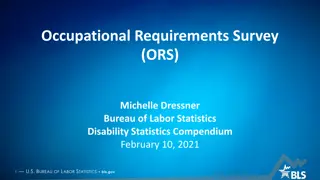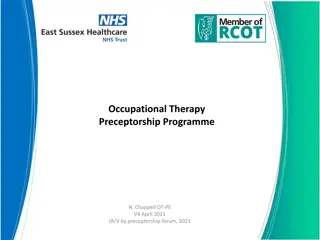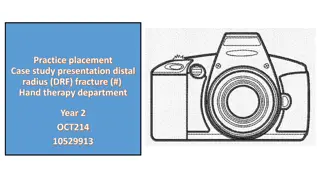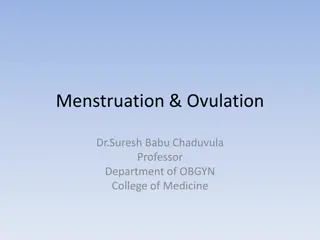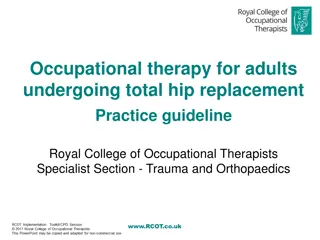Occupational Therapy Tips for Supporting Children with Menstruation Challenges
Parents of special-needs children often face challenges during menstruation. Preparation through teaching and using occupational therapy strategies can ease the transition. Tips include considering comfort, access, techniques for using pads, and incorporating playtime for learning. Social stories and practical advice are highlighted to support parents in guiding their children through this natural process.
Download Presentation

Please find below an Image/Link to download the presentation.
The content on the website is provided AS IS for your information and personal use only. It may not be sold, licensed, or shared on other websites without obtaining consent from the author.If you encounter any issues during the download, it is possible that the publisher has removed the file from their server.
You are allowed to download the files provided on this website for personal or commercial use, subject to the condition that they are used lawfully. All files are the property of their respective owners.
The content on the website is provided AS IS for your information and personal use only. It may not be sold, licensed, or shared on other websites without obtaining consent from the author.
E N D
Presentation Transcript
6 OT Tips What else to remember? Support Challenges with menstruation & possible solutions for your special-needs child Occupational Therapy (OT) Making it work for menstruation.
Note from a Nayi Disha mother... Parents of a special-needs child often feel like their world has turned upside down during the difficult days of PMS and bleeding. Here are some things you can do ahead of time to prepare for the transition: Teach your child that they will grow and that s ok! Teach them that this is a normal aspect of having a female body! Like mummy! The more we prepare our children and ourselves for these changes and help them understand that they will be okay, the easier the transition into young adulthood! So what s a good way to teach your child about menstruation? Social stories.
6 OT Tips What else to remember? Support 6 Tips Using Occupational Therapy Ms. Snigdha Indukuri Ms. Snehal Vaidya Behaviour Therapist Occupational Therapist PRACTICAL TIPS FOR YOUR CHILD'S MENSTRUATION REGIME.
6 OT Tips What else to remember? Support 1 Comfort Please take into account your child's particular sensory needs when selecting menstrual pads. Will your child prefer a cottany feel? Will the fragrance irritate them? Will they be comfortable with net lining? Remember: Just because your child prefered one brand this month, doesn't mean the same brand works every time.
6 OT Tips What else to remember? Support 2 Access Most special-needs children are strict about their habits & routine. They may not cope well with changes in location of their equipment. Place pads at a location where your child can easily access them. Same goes for other hygine equipment like underpants, tissues, soap, etc.
6 OT Tips What else to remember? Support 3 Technique There are three options of fixing a pad to underpants. Select what works best for your child depending on their ability. Use visual aids to help them understand either one of these processes: 1. Wearing a diaper, 2. First pasting a pad on underpants & then putting it on, 3. First putting on underpants halfway through & then pasting a pad.
6 OT Tips What else to remember? Support 4 Play Time! Use your child s play doll to teach pad-handling techniques. Teach your child to practice fitting / changing a pad on their favorite doll. Soon, this will make it easier for them to put a pad on for themselves.
6 OT Tips What else to remember? Support 5 Visual Cues (Pad Expiry) Similarly, explain that... A BIG RED SPOT means that the pad might need changing soon. MEDIUM RED SPOT means pad will need changing only in a few hours. An ungrowing small red spot means periods have almost ended, & pads will no longer be needed. Red on underpants means wash undies immediately + pad must be adjusted.
6 OT Tips What else to remember? Support 6 Visual Cues (Changing Pads) &/or, explain that... It is a good practice to wear a pad a few hours in anticipation of bleeding rather than after bleeding begins. It is also best not to wear pads longer than required. They may cause rashes / infection. Thus, give your child specific days on which to begin & stop wearing pads, according to their cycle. Set a routine of specific time slots for changing pads. Eg: Once at 8am, then 2pm, & again at 8pm.
6 OT Tips What else to remember? Support Warning Regardless of the amount of bleeding, teach your child to never keep a pad on for longer than 5 hours. This may cause infection.
6 OT Tips What else to remember? Support This Needn't Be Painful For You Depending on their physical abilities, your child may be entirely dependent on you for their menstrual management. They may lean their body on you when putting on underpants. This may cause neck / back pain. During this process, find a suitable position for yourself to avoid undue physical distress. It is important to suit menstrual routines to you & your child's physical abilities.
6 OT Tips What else to remember? Support Grooming is Self-Expression Let your child see themselves in clothes, make up, hair styles that they prefer. This is crucial to a healthy self-image. Allowing them this freedom will preserve their self-esteem, boost their self-confidence, & encourage calm nerves.
6 OT Tips What else to remember? Support & parents are here to help! Nayi Disha s parent WhatsApp groups & monthly support groups are here for all your doubts regarding raising a special-needs child. To join the parent community &/or for more information, write to us: contactus@nayi-disha.org and visit www.nayi-disha.org for more resources on Menstrual care and health of your child.
6 OT Tips What else to remember? Support Whenever you re feeling overwhelmed, reach out to the many Nayi Disha parents who ve helped their children thrive against all odds! It s possible and we re here to help you through it!
